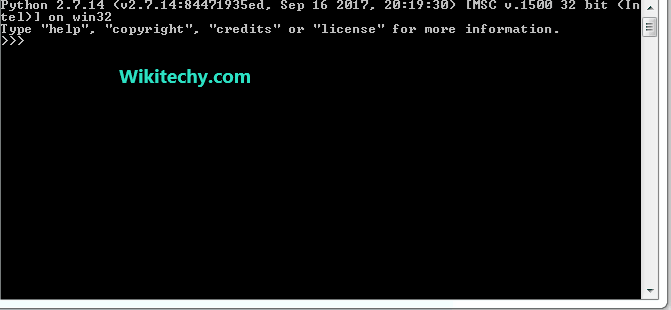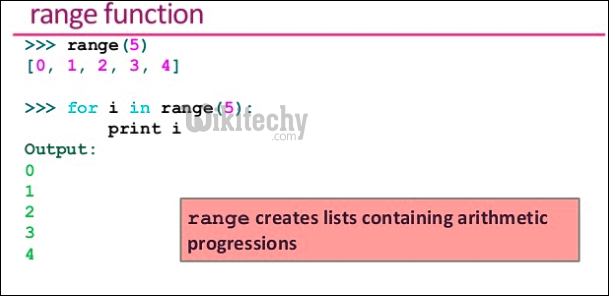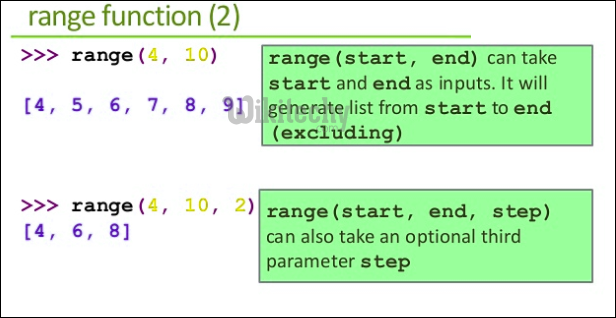
Learn Python - Python tutorial - python ranges - Python examples - Python programs
range() and xrange() are two functions that could be used to iterate a certain number of times in for loops in Python. In Python 3, there is no xrange , but the range function behaves like xrange in Python 2.If you want to write code that will run on both Python 2 and Python 3, you should use range().

range() – This returns a list of numbers created using range() function.
xrange() – This function returns the generator object that can be used to display numbers only by looping. Only particular range is displayed on demand and hence called “lazy evaluation“.

Both are implemented in different ways and have different characteristics associated with them. The points of comparisons are:
- Return Type
- Memory
- Operation Usage
- Speed
range() returns – the list as return type.
xrange() returns – xrange() object.
python - Sample - python code :
# Python code to demonstrate range() vs xrange()
# on basis of return type
# initializing a with range()
a = range(1,10000)
# initializing a with xrange()
x = xrange(1,10000)
# testing the type of a
print ("The return type of range() is : ")
print (type(a))
# testing the type of x
print ("The return type of xrange() is : ")
print (type(x))python tutorial - Output :
The return type of range() is : <type 'list'=""> The return type of xrange() is : <type 'xrange'=""> </type></type>
The variable storing the range created by range() takes more memory as compared to variable storing the range using xrange(). The basic reason for this is the return type of range() is list and xrange() is xrange() object.
python - Sample - python code :
# Python code to demonstrate range() vs xrange()
# on basis of memory
import sys
# initializing a with range()
a = range(1,10000)
# initializing a with xrange()
x = xrange(1,10000)
# testing the size of a
# range() takes more memory
print ("The size allotted using range() is : ")
print (sys.getsizeof(a))
# testing the size of a
# range() takes less memory
print ("The size allotted using xrange() is : ")
print (sys.getsizeof(x))python tutorial - Output :
The size allotted using range() is : 80064 The size allotted using xrange() is : 40
As range() returns the list, all the operations that can be applied on the list can be used on it. On the other hand, as xrange() returns the xrange object, operations associated to list cannot be applied on them, hence a disadvantage.
python - Sample - python code :
# Python code to demonstrate range() vs xrange()
# on basis of operations usage
# initializing a with range()
a = range(1,6)
# initializing a with xrange()
x = xrange(1,6)
# testing usage of slice operation on range()
# prints without error
print ("The list after slicing using range is : ")
print (a[2:5])
# testing usage of slice operation on xrange()
# raises error
print ("The list after slicing using xrange is : ")
print (x[2:5])Error:
Traceback (most recent call last):
File "1f2d94c59aea6aed795b05a19e44474d.py", line 18, in
print (x[2:5])
TypeError: sequence index must be integer, not 'slice'
python tutorial - Output :
The list after slicing using range is : [3, 4, 5] The list after slicing using xrange is :
Because of the fact that xrange() evaluates only the generator object containing only the values that are required by lazy evaluation, therefore is faster in implementation than range().
Important Points:
- If you want to write code that will run on both Python 2 and Python 3, use range() as the xrange funtion is deprecated in Python 3
- range() is faster if iterating over the same sequence multiple times.
- xrange() has to reconstruct the integer object every time, but range() will have real integer objects. (It will always perform worse in terms of memory however)
